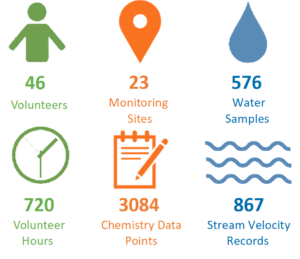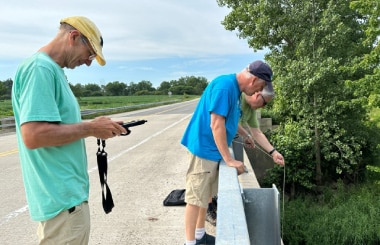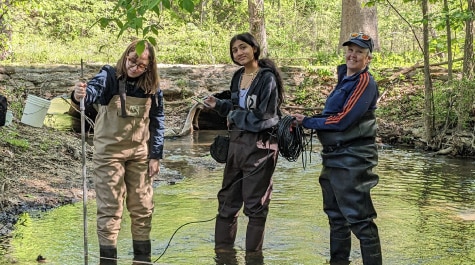 September marked the end of another great season of Chemistry and Flow Monitoring in the Huron River and Downriver watersheds. Over the past 21 years, dedicated volunteers have collected thousands of water samples and measured the flow of water in rivers and streams throughout Southeast Michigan. This year, 46 volunteers collected 576 water samples and 867 stream velocity measurements from 23 monitoring sites during the 24-week 2023 monitoring season. This data will be made available in early 2024 on HRWC’s new Water Chemistry Dashboard that is currently live with data through 2022.
September marked the end of another great season of Chemistry and Flow Monitoring in the Huron River and Downriver watersheds. Over the past 21 years, dedicated volunteers have collected thousands of water samples and measured the flow of water in rivers and streams throughout Southeast Michigan. This year, 46 volunteers collected 576 water samples and 867 stream velocity measurements from 23 monitoring sites during the 24-week 2023 monitoring season. This data will be made available in early 2024 on HRWC’s new Water Chemistry Dashboard that is currently live with data through 2022.

Each year, a team of dedicated volunteers gathers the data for our Chemistry and Flow program. The 46 volunteers this year, record involvement since pre-pandemic, put in over 700 hours of service to HRWC. They measured temperature, dissolved oxygen, pH, conductivity, and total dissolved solids using handheld water quality sondes; recorded water velocity along cross-sections of tributaries and the main stem of the river; and collected waters samples for analysis of nutrients, sediments, and bacteria. Samples were analyzed by our partner laboratories: City of Ann Arbor Water Treatment Plant for Washtenaw County and the South Huron Valley Utility Authority for Wayne County. This season’s program has provided HRWC with hundreds of high-quality measurements that captured the gamut of watershed conditions this summer ranging from a flash drought in June to record rain fall in August.

HRWC’s analysis of the measurements guides local efforts to protect and restore the Huron River and Downriver waterways. HRWC and our stormwater partners – the Middle Huron Partners and Alliance of Downriver Watersheds – use this data to shape restoration efforts and stormwater management decisions. This data-driven approach to stormwater management contributes to the development of watershed management plans and total maximum daily load (TMDL) implementation plans that drive decision making. The recommendations outlined in these plans have led to phosphorus fertilizer bans; residential rain garden programs; commercial green stormwater infrastructure projects; and the development of a real-time network of flow sensors throughout the watershed. The monitoring program concurrently tracks the success of these strategies, and the results in Washtenaw and Wayne counties confirm progress towards reducing contamination, especially nutrients.
Annual Chemistry and Flow Monitoring is vital for identifying trends and changes as the Huron River watershed and Downriver waterways continue to change and experience additional stressors from climate change. HRWC looks forward to continuing this work thanks to the sustained support of our partners and volunteers.
For additional information about the Chemistry and Flow Monitoring Program visit our program webpage or read about the program history. If you are interested in volunteering with the program in 2024, sign up to volunteer here and subscribe to our e-newsletter to stay in the loop on future opportunities.



